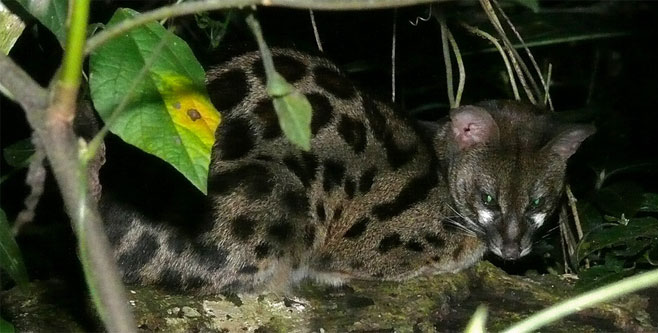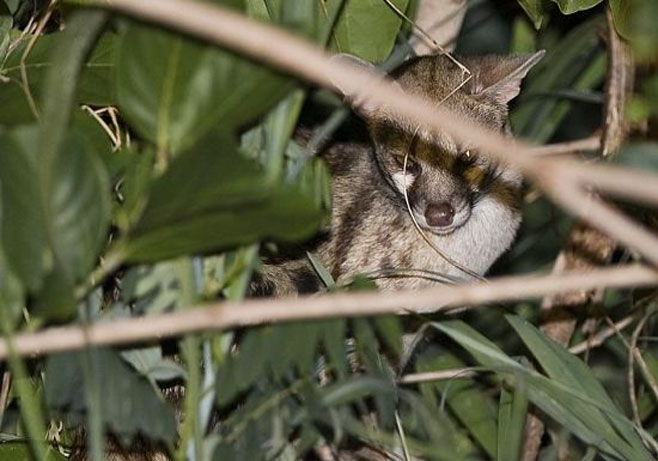|
Genetta genetta (Small-spotted genet, Common
genet)
kleinkolmuskejaatkat
[Afrikaans]; Gemeine Ginsterkatze, Kleinfleck Ginsterkatze [German];
genette vulgaire, genette commune [French]; kanu [Swahili]; insimba
[isiNdebele] [siSwati]; inyhwagi [isiXhosa]; insimba enamabala [isiZulu];
tshipa ya dithokolo tse nyenyane [Sepedi]; tshipa, tshipo e matheba
a masesane [Sesotho]; tshipa [Setswana]; tsimba [Shona, Tshivenda];
nsimba-maxanatsi [Xitsonga]; sipa [Lozi]; unsiimba [Yei]; !Noreb [Nama, Damara]
Life
>
Eukaryotes >
Opisthokonta >
Metazoa (animals) > Bilateria > Deuterostomia >
Chordata > Craniata > Vertebrata (vertebrates) >
Gnathostomata (jawed vertebrates) > Teleostomi (teleost
fish) > Osteichthyes (bony fish) > Class:
Sarcopterygii (lobe-finned fish) > Stegocephalia
(terrestrial vertebrates) > Reptiliomorpha > Amniota >
Synapsida (mammal-like reptiles) > Therapsida > Theriodontia
> Cynodontia > Mammalia (mammals)
> Placentalia (placental mammals) > Laurasiatheria
> Ferungulata > Ferae > Carnivora >
Family: Viverridae (civets and genets)
> Subfamily: Viverrinae
 |
|
Small-spotted genet, Kibale Forest National Park,
Uganda. [photo
Bernard Dupont ©] |
 |
|
Small-spotted genet, Kruger National Park, South
Africa. [photo Trevor Hardaker ©] |
A nocturnal carnivore with a varied diet that
includes mainly invertebrates and small rodents but also reptiles,
frogs, birds and wild fruits. Similar in appearance to the
Large-spotted genet but spots are smaller and darker, the tail tip
is usually white, the black-and-white facial markings are more
prominent, the chin is dark and it has a crest of longer
black-tipped along the spine that is raised when the animal is
threatened.
Description
Small-spotted genet has a long slender body and
tail and short legs. The body is off-white to grayish white and
spotted with dark-brown to almost black spots and bars. The long
tail is ringed in black with a white tip. A crest of longer black–tipped hairs runs along the spine and can be raised when the animal
is threatened. The ears are fairly elongated, rounded and thin, they
appear almost transparent. The eyes are large, characteristic of its
nocturnal lifestyle with distinct white patches underneath. They
have excellent binocular vision this allows them to judge distances
very accurately and jump from branch to branch or on its prey. There
are sharp, curved protractile claws on both the front and back feet.
Size
Total Body Length: 86 – 100 cm; weight
range 1.5 – 3.2 kg.
Dental Formula
I C C P P M M =
40 =
40
Distribution and habitat
Widespread in most of southern Africa, but is
found marginally in KwazuluNatal, does not occur in northern and
eastern Zimbabwe, and is not found in most of Mozambique. Occurs in
a wide variety of habitats from desert margins to high rainfall
areas.
General behaviour
Small-spotted genets are nocturnal and lie up and remain hidden
during the day. They are good climbers and well adapted to an
arboreal way of life but also spend time foraging on the ground.
Normally solitary they are occasionally seen in pairs.
Food
Genets are carnivores. Invertebrates and small
rodents are their primary food, but they also eat reptiles,
amphibians, birds and wild fruits. Excellent eyesight and their
lithe build make them highly effective predators. They combine speed
and stealth, stalking their prey in a series pf dashes broken by
short pauses.
Reproduction
After a gestation period of about 70 days, a
litter of 2 – 4 young are born in summer in a nest hidden in holes,
rock crevices or amongst dense vegetation. They are blind at birth.
The eyes open after about 8 days and they venture from the nest soon
afterwards. They are weaned at 9 weeks although they eat solid food
before this. After a year the young are thought to be independent.
Life span: 8 years maximum age
Conservation
Small-spotted genets can come into conflict
with poultry farmers as they will kill for more birds than they
require if they get into a hen house. Unfortunately they are common
roadkills by becoming disorientated and trapped by car headlights at
night. The small-spotted genet is not regarded as threatened and its
conservation status is low risk.
Text by Denise Hamerton |
